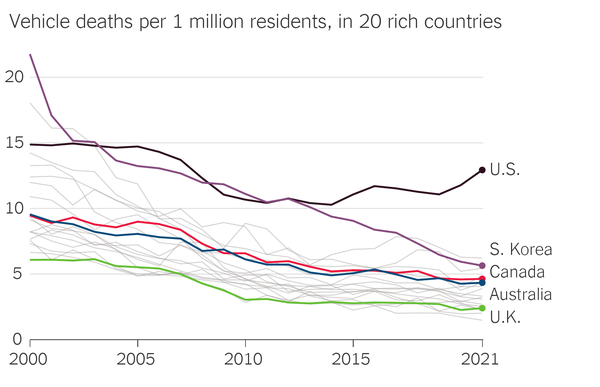In the United States, traffic fatalities have reached alarming levels, with a person killed on the roads approximately every 12 minutes. In 2022 alone, more than 42,500 lives were lost in car crashes, a death toll comparable to or exceeding that of major public health threats such as influenza and gun violence.
A Public Health Crisis
Traffic-related injuries and deaths resulted in over $55 billion in healthcare costs in 2022, according to the Centers for Disease Control and Prevention (CDC). Pedestrian fatalities, in particular, have surged, hitting 7,522 deaths in 2022—the highest number in over 40 years.
“We have not recognized that traffic violence is a preventable public health crisis,” asserts Amy Cohen, co-founder of Families for Safe Streets.
Causes and Solutions
Experts attribute the increase in traffic deaths to a combination of factors, including more reckless driving, reduced traffic enforcement, and the proliferation of larger, deadlier SUVs and trucks. However, they also point to a fundamental issue: the U.S. transportation system prioritizes efficient movement and economic development over safety.
In response, the Biden administration is advocating for a “safe system approach” to transportation—a strategy aimed at integrating safety into road and vehicle design and transportation policies. This approach involves lowering speed limits, narrowing roads, creating dedicated lanes for cyclists, and enhancing pedestrian buffers. Additionally, it seeks to reduce reliance on cars, which contribute to sedentary lifestyles and air pollution, while promoting public transportation.
In 2021, the Biden administration allocated over $20 billion for transportation safety programs through the Infrastructure Investment and Jobs Act. States and localities are also taking action. New York and Michigan have enacted laws permitting local jurisdictions to lower speed limits, and Los Angeles voters recently approved a ballot initiative to redesign streets, invest in public transportation, and improve pedestrian and cyclist infrastructure.
Personal Impact and Political Resistance
Despite these efforts, resistance remains, largely due to the deep cultural and economic ties to automobiles in the U.S. This resistance often overlooks the real-life impact on individuals and communities.
In a Latino working-class neighborhood in Los Angeles, María Rivas Cruz and her fiancé, Raymond Olivares, were struck by a driver going 70 mph in a 40-mph zone. Olivares died at the scene, and Rivas Cruz, now 28, suffers from chronic pain and walks with a cane. Residents had long requested safety improvements such as lower speed limits and more marked crosswalks. Following the tragedy, the county installed protective steel posts, which Rivas Cruz described as merely a “band-aid” solution.
“There’s so much death going on,” Rivas Cruz laments. “The representatives have failed us.”



